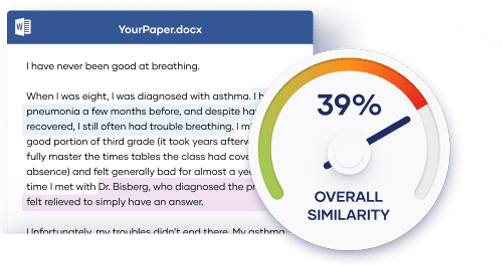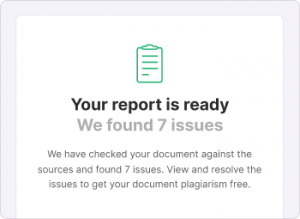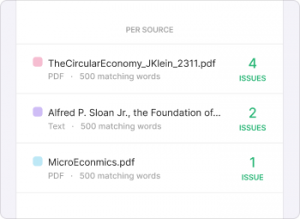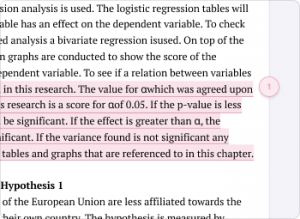What Is Self-Plagiarism? | Definition & How to Avoid It
Plagiarism often involves using someone else’s words or ideas without proper citation, but you can also plagiarise yourself. Self-plagiarism means reusing work that you have already published or submitted for a class. It can involve:
- Resubmitting an entire paper
- Copying or paraphrasing passages from your previous work
- Recycling previously collected data
- Separately publishing multiple articles about the same research
Self-plagiarism misleads your readers by presenting previous work as completely new and original. If you want to include any text, ideas, or data that you already submitted in a previous assignment, be sure to inform your readers by citing yourself.
Examples of self-plagiarism
You may be committing self-plagiarism if you:
- Submit an assignment from a previous academic year to a current class
- Recycle parts of an old assignment without citing it (e.g., copy-pasting sections or paragraphs from previously submitted work)
- Use a dataset from a previous study (published or not) without letting your reader know
- Submit a manuscript for publication containing data, conclusions, or passages that have already been published without citing your previous publication
- Publish multiple similar papers about the same study in different journals
Examples: Self-plagiarism
Why is self-plagiarism wrong?
While self-plagiarism may not be considered as serious as plagiarising someone else’s work, it’s still a form of academic dishonesty and can have the same consequences as other forms of plagiarism. Self-plagiarism:
- Shows a lack of interest in producing new work
- Can involve copyright infringement if you reuse published work
- Means you’re not making a new and original contribution to knowledge
- Undermines academic integrity, as you’re misrepresenting your research
It can still be legitimate to reuse your previous work in some contexts, but you need to acknowledge you’re doing so by citing yourself.
How to cite yourself
It can be legitimate to reuse pieces of your previous work, but you need to ensure you have explicit permission from your instructor before doing so, and you must cite yourself.
You can cite yourself just like you would cite any other source. The examples below show how you could cite your own unpublished thesis or dissertation in various styles.
Example: Citing an unpublished thesis or dissertation
| APA format | Author last name, Initials. (Year). Title: Subtitle [Unpublished type of thesis or dissertation]. University Name. URL or DOI |
|---|---|
| APA reference entry | Merkus, J. (2018). The power of reading: The effect of different reading methods on the vocabulary of multilingual children [Unpublished master’s thesis]. Radboud University. |
| APA in-text citation | (Merkus, 2018) |
| APA format | Author last name, First name. Title: Subtitle. Year. University Name, type of thesis or dissertation. |
|---|---|
| MLA Works Cited entry | Merkus, Julia. The Power of Reading: The Effect of Different Reading Methods on the Vocabulary of Multilingual Children. Radboud University, master’s thesis. |
| MLA in-text citation | (Merkus, 15) |
| Chicago bibliography entry | Last name, First name. “Title: Subtitle.” Type of thesis or diss., University Name, Year.
Merkus, Julia. “The Power of Reading: The Effect of Different Reading Methods on the Vocabulary of Multilingual Children.” Master’s thesis, Radboud University, 2018. |
|---|---|
| Full note | Author first name Last name, “Title: Subtitle” (type of thesis or diss., University Name, Year), Page number(s).
1. Julia Merkus, “The Power of Reading: The Effect of Different Reading Methods on the Vocabulary of Multilingual Children” (master’s thesis, Radboud University, 2018), 15. |
| Short note | Author last name, “Shortened Title,” Page number(s).
2. Merkus, “Power of Reading,” 21. |
How do educational institutions detect self-plagiarism?
In addition to plagiarism software databases, many educational institutions keep databases of submitted assignments. Sometimes, they even have access to databases at other institutions. If you hand in even a portion of an old assignment a second time, the plagiarism software will flag it as self-plagiarism.
Online plagiarism checkers not affiliated with a university don’t have access to the internal databases of educational institutions, and therefore their software cannot check your document for self-plagiarism.
In addition to our Plagiarism Checker, Scribbr also offers a Self-Plagiarism Checker. This unique tool allows you to upload your own original sources and compare them with your new assignment. It will flag any unintentional self-plagiarism, in addition to other forms of plagiarism, and helps ensure that you add the correct citations before submitting your assignment.
Scribbr’s Self-Plagiarism Checker
Online plagiarism scanners do not have access to internal university databases, and therefore cannot check your document for self-plagiarism.
Using Scribbr’s Self-Plagiarism Checker, you can upload your previous work and compare it to your current document:
- Your thesis or dissertation
- Your papers or essays
- Any other published or unpublished documents
The checker will scan the texts for similarities and flag any passages where you might have self-plagiarised.
Frequently asked questions about plagiarism
Cite this Scribbr article
If you want to cite this source, you can copy and paste the citation or click the ‘Cite this Scribbr article’ button to automatically add the citation to our free Reference Generator.
George, T. (2022, July 26). What Is Self-Plagiarism? | Definition & How to Avoid It. Scribbr. Retrieved 27 October 2025, from https://www.scribbr.co.uk/preventing-plagiarism/self-plagiarism/



